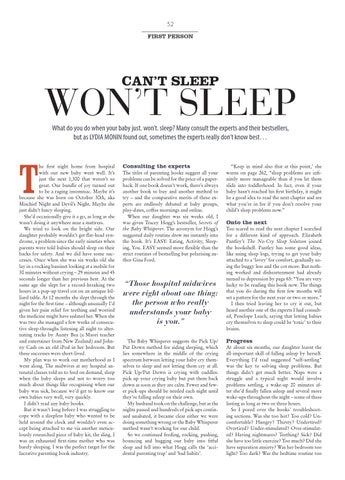52 FIRST PERSON
CAN’T SLEEP
WON’T SLEEP What do you do when your baby just. won’t. sleep? Many consult the experts and their bestsellers, but as LYDIA MONIN found out, sometimes the experts really don’t know best…
T
he first night home from hospital with our new baby went well. It’s just the next 1,300 that weren’t so great. Our bundle of joy turned out to be a raging insomniac. Maybe it’s because she was born on October 30th, aka Mischief Night and Devil’s Night. Maybe she just didn’t fancy sleeping. She’d occasionally give it a go, as long as she wasn’t doing it anywhere near a mattress. We tried to look on the bright side. Our daughter probably wouldn’t get flat-head syndrome, a problem since the early nineties when parents were told babies should sleep on their backs for safety. And we did have some successes. Once when she was six weeks old she lay in a rocking bassinet looking at a mobile for 30 minutes without crying – 29 minutes and 45 seconds longer than her previous best. At the same age she slept for a record-breaking two hours in a pop-up travel cot on an antique billiard table. At 12 months she slept through the night for the first time – although unusually I’d given her pain relief for teething and worried the medicine might have sedated her. When she was two she managed a few weeks of consecutive sleep-throughs listening all night to alternating tracks by Aunty Bea (a Maori teacher and entertainer from New Zealand) and Johnny Cash on an old iPod in her bedroom. But these successes were short-lived. My plan was to work out motherhood as I went along. The midwives at my hospital antenatal classes told us to feed on demand, sleep when the baby sleeps and not to worry too much about things like recognising when our baby was sick, because we’d get to know our own babies very well, very quickly. I didn’t read any baby books. But it wasn’t long before I was struggling to cope with a sleepless baby who wanted to be held around the clock and wouldn’t even accept being attached to me via another meticulously researched piece of baby kit, the sling. I was an exhausted first-time mother who was barely sleeping. I was the perfect target for the lucrative parenting book industry.
MI April_May 2015_Sleeping.indd 52
Consulting the experts The titles of parenting books suggest all your problems can be solved for the price of a paperback. If one book doesn’t work, there’s always another book to buy and another method to try – and the comparative merits of these experts are endlessly debated at baby groups, play-dates, coffee mornings and online. When our daughter was six weeks old, I was given Tracey Hogg’s bestseller, Secrets of the Baby Whisperer. The acronym for Hogg’s suggested daily routine drew me instantly into the book. It’s EASY: Eating, Activity, Sleeping, You. EASY seemed more flexible than the strict routines of bestselling but polarising author Gina Ford.
“Those hospital midwives were right about one thing: the person who really understands your baby is you.” The Baby Whisperer suggests the Pick Up/ Put Down method for aiding sleeping, which lies somewhere in the middle of the crying spectrum between letting your baby cry themselves to sleep and not letting them cry at all. Pick Up/Put Down is crying with cuddles: pick up your crying baby but put them back down as soon as they are calm. Fewer and fewer pick-ups should be needed each night until they’re falling asleep on their own. My husband took on the challenge, but as the nights passed and hundreds of pick ups continued unabated, it became clear either we were doing something wrong or the Baby Whisperer method wasn’t working for our child. So we continued feeding, rocking, pushing, bouncing and hugging our baby into fitful sleep and fell into what Hogg calls the ‘accidental parenting trap’ and ‘bad habits’.
“Keep in mind also that at this point,’ she warns on page 262, “sleep problems are infinitely more manageable than if you let them slide into toddlerhood. In fact, even if your baby hasn’t reached his first birthday, it might be a good idea to read the next chapter and see what you’re in for if you don’t resolve your child’s sleep problems now.”
Onto the next Too scared to read the next chapter I searched for a different kind of approach. Elizabeth Pantley’s The No-Cry Sleep Solution joined the bookshelf. Pantley has some good ideas, like using sleep logs, trying to get your baby attached to a ‘lovey’ for comfort, gradually using the buggy less and the cot more. But nothing worked and disheartenment had already turned to depression by page 65: “You are very lucky to be reading this book now. The things that you do during the first few months will set a pattern for the next year or two or more.” I then tried leaving her to cry it out, but heard another one of the experts I had consulted, Penelope Leach, saying that letting babies cry themselves to sleep could be ‘toxic’ to their brains.
Progress At about six months, our daughter learnt the all-important skill of falling asleep by herself. Everything I’d read suggested “self-settling” was the key to solving sleep problems. But things didn’t get much better. Naps were a struggle and a typical night would involve problems settling, a wake-up 20 minutes after she’d finally fallen asleep and several more wake-ups throughout the night – some of these lasting as long as two or three hours. So I pored over the books’ troubleshooting sections. Was she too hot? Too cold? Uncomfortable? Hungry? Thirsty? Undertired? Overtired? Under-stimulated? Over-stimulated? Having nightmares? Teething? Sick? Did she have too little exercise? Too much? Did she have separation anxiety? Was her bedroom too light? Too dark? Was the bedtime routine too
23/03/2015 15:36
